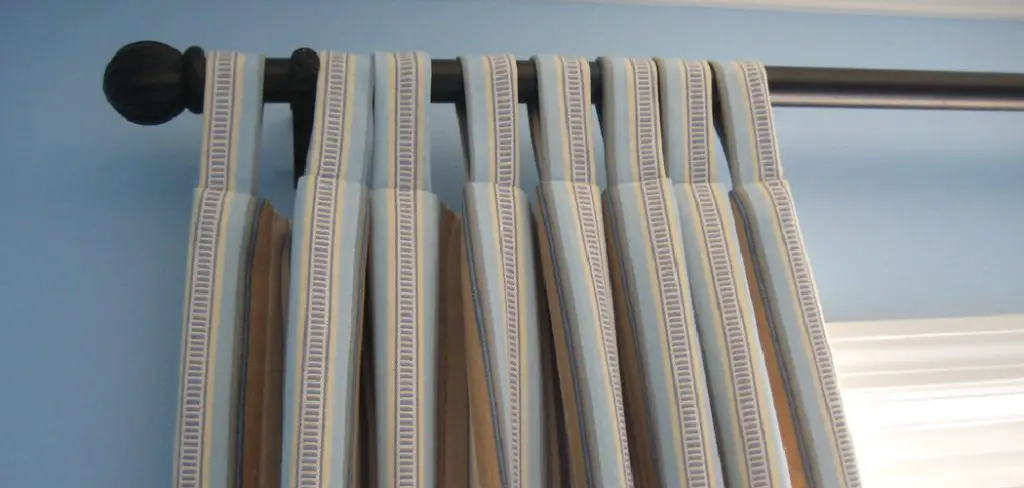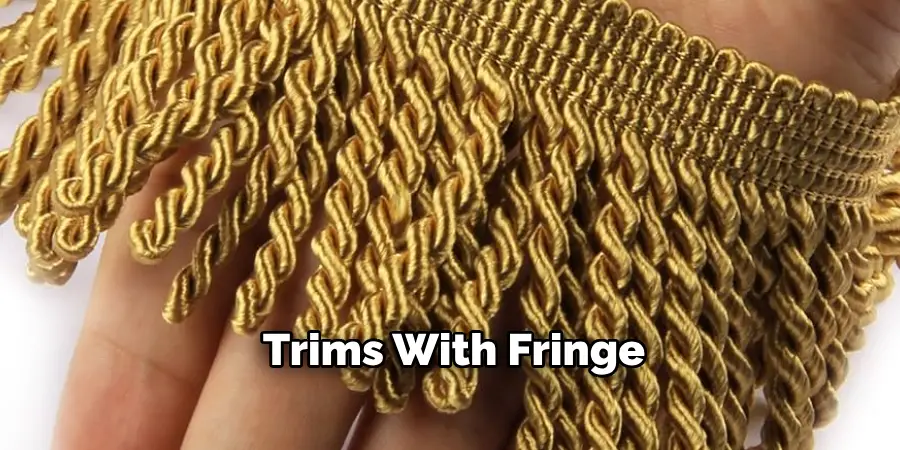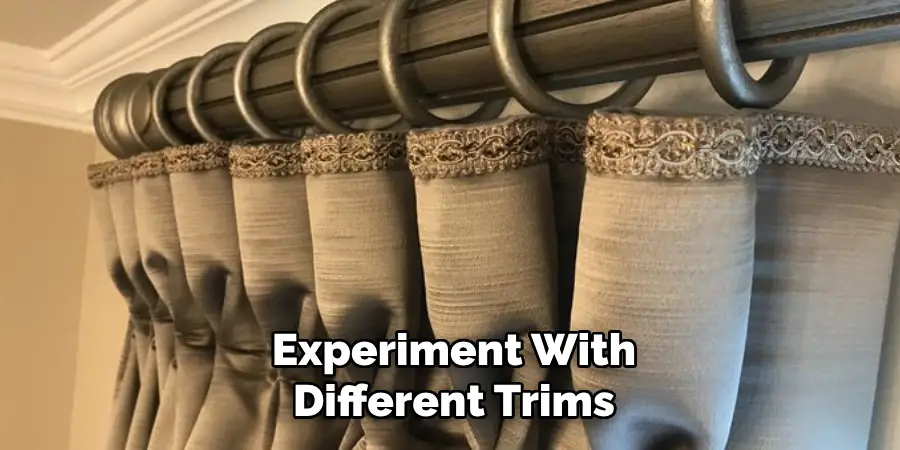Transforming your living space doesn’t have to entail a complete overhaul; sometimes, the subtle, artful touches make all the difference. The simple act of adding trim to curtains can elevate the mundane to the magnificent. This guide will walk you through the delightful array of possibilities—from creating a bespoke feel with luxurious tassels to injecting a burst of personality with vibrant ribbons.

You’ll discover how to enhance style, introduce visual interest, personalize on a budget, and understand the available materials and methods. Let’s begin the journey on how to add trim to curtains!
Choosing the Right Trim
Choosing the right trim for your curtains requires an eye for detail and an understanding of the design aesthetic you wish to achieve. Begin by evaluating the existing décor and determining whether you want the trims to blend seamlessly or stand out as a focal point. For a room with modern decor, geometric patterns, or sleek, metallic trims might be ideal. On the other hand, a vintage-themed room could be enhanced with lace or ruffled trim.
Consider the durability and maintenance of the trim material, especially in high-humidity areas like kitchens and bathrooms. Natural fibers like cotton and linen are classic choices, but synthetic blends can offer more resilience and less shrinkage. Remember to check for colorfastness if the curtains are likely exposed to direct sunlight to prevent fading over time.
Lastly, factor in the practicalities of attachment methods. If you lack confidence in your sewing skills, opt for no-sew trims like iron-on or adhesive options. Conversely, if you are handy with a needle and thread, consider more intricate sew-on trims that can impart a long-lasting and professional finish. Regardless of the trim you select, ensuring it complements the room’s fabric, color, and overall tone will guarantee a harmonious and striking result.
How to Add Trim to Curtains: A Beginner’s Guide
1. Selecting Your Attachment Method

Selecting the right attachment method for your trim is just as crucial as the choice of trim itself. The method you choose will depend on your skill level, the tools at your disposal, and the final look you are aiming for.
For those who are adept with a sewing machine or hand-stitching, sew-on methods offer a secure attachment that’s likely to have the longest lifespan. Machine stitching is faster and gives a uniform line, while hand-stitching allows for more intricate control, especially when sewing on delicate trims like beads or sequins.
Conversely, if you’re looking for a quick fix or don’t have sewing skills, there are various no-sew options available. Iron-on adhesive tapes offer a clean line and can be used for both heavy and light trims alike. For trims that won’t be heavily handled, fabric glue is an effective alternative. It allows for a bit more maneuverability before setting, making it perfect for creating curved patterns or adding trims to more delicate fabric.
Lastly, there are clip-on or pin-on trims for those looking for a removable option. These are ideal for temporary decorations or for those who like to frequently change the look of their decor.

In all cases, it’s important to test your chosen method on a small section of the trim and curtain fabric first. This will allow you to check for any changes in the curtain’s drape and the security of the attachment and to ensure that the fabric isn’t damaged by the chosen attachment method.
2. Planning Your Design
When planning your design, imagine the desired ambiance and how the trim can reinforce that vision. For a lively and dynamic space, consider vibrant and patterned trims that draw attention. If tranquility is your goal, select trims that are subtle and create a serene flow throughout the room. Always remember the pattern’s scale in relation to the curtain size – oversized patterns can overwhelm small windows, and delicate trims can disappear on large swaths of fabric.
As you conceptualize your design, sketch out possibilities or use digital design tools to visualize the end result. This can help in determining the balance between the curtain and trim. Consider whether the trims will run horizontally, creating a border effect, or vertically, adding length and elegance. Diagonal or asymmetric applications can be an artistic expression for an eclectic touch.
Moreover, consider the interplay of colors and textures. Using contrasting colors can transform the trim into a striking design element while matching colors with different textures can add depth and interest without stark contrasts. Always keep practical considerations in mind as well; trims with fringe or beads might not be the best choice for a child’s room, where they could be a safety hazard.

Finally, don’t forget to account for how the curtains will function in the space. Will they be drawn frequently or remain stationary? Your design should not impede their usability, ensuring that both aesthetics and function go hand in hand.
3. Adding the Finishing Touches
As you approach the final stage of curtain trimming, adding the finishing touches is key to creating a cohesive look. This involves securing the trim and ensuring that it lies flat and remains even throughout. For sewn-on trims, pressing with an iron to establish a crisp edge adds a professional touch. If using fabric glue, apply it sparingly to prevent any seepage that could tarnish the trim’s appearance.
Double-check that all ends are neatly tucked in or secured to prevent fraying, and consider the practicality of the trim for laundering. If the curtains will be washed frequently, make sure your trim choice can withstand the cleaning process. Lastly, step back and view the curtains from different angles and distances. This helps to spot any inconsistencies and make any final adjustments. Remember, the beauty is in the details – ensure they underscore the elegance and style of your space.
That’s it! You’ve now learned how to add trim to curtains like a pro. With the right attachment method, a well-planned design, and some finishing touches, you can elevate your curtains from simple window coverings to stylish statement pieces in any room. Don’t be afraid to experiment with different trims and designs to find the perfect combination for your unique space.

Advanced Techniques for the Bold and Daring
Taking curtain design to the next level requires a bit of courage and creativity for those willing to experiment with advanced techniques. If you consider yourself bold and daring, try incorporating three-dimensional elements into your curtains.
This can include attaching feathers, artificial flowers, or even lightweight jewelry to create a statement piece that adds volume and texture. These elements should be carefully chosen to complement the room’s overall aesthetic while still standing out as an artistic feature.
Mixing media is another adventurous approach. Try combining different fabric types, like pairing a sleek satin with a rough burlap, to juxtapose textures and evoke a more modern vibe. Also, consider integrating metal elements, such as chains or studs, to add an industrial edge that catches the light and provides a unique visual appeal.
For those with a meticulous eye for detail, applying dye techniques can elevate the ordinary to extraordinary. Ombre dyeing, where color gradually fades from dark to light or vice versa, can add depth and an element of surprise to your curtains. For more intricate patterns, consider batik or tie-dye techniques, which allow for creative expression and ensure that no two curtains are exactly the same.

LED lighting is rapidly becoming a darling of the interior design world. Embedding small LED lights within the trim can highlight specific areas of the curtain, creating an enchanting nighttime scene in your room. However, this technique requires careful planning and understanding of electronics to ensure safety and functionality.
Lastly, for a truly avant-garde addition, you might even venture into the world of technology with responsive textiles that change color or pattern based on light, temperature, or even the touch of a hand. While these are cutting-edge and may require a significant investment, the result is a living piece of decor that constantly interacts and evolves with the environment.
Before diving into these advanced techniques, always consider the practicality and safety of the additions you choose. Ensure that all items are securely attached to withstand the movement of the curtains and that any electrical components are safely installed. The goal is to push the boundaries of traditional curtain design while maintaining a beautiful and functional space.
Troubleshooting Tips
When embarking on the journey of curtain design, encountering a few hurdles along the way is not uncommon. Here are some essential troubleshooting tips to keep your project on track:
- Trim Weight Issues: If the trim is causing the curtain to hang unevenly, consider using a lighter material or reinforcing the curtain panel with a heftier fabric to provide balance.
- Adhesive Problems: When using fabric glue, if you find it is not adhering well, ensure the curtain fabric is clean and free of any finishes that might repel the glue. Alternatively, try a different type of adhesive that is specifically formulated for fabric.
- Color Bleeding: To prevent the color transfer from the trim to the curtain, especially during washing, pre-wash the trim using a color-catching sheet that can help lock in the dye.
- Uneven Application: If the trim is crooked, use a laser level or tailor’s chalk to mark a guideline before application. This ensures a straight line.
- Fraying Edges: Apply a small amount of clear fabric sealant to the cut ends of your trim to stop fraying. Test on a small section first to ensure it doesn’t stain the material.
- Lighting Malfunctions: For curtains with embedded LED lighting, always test the light strip before and after installation to ensure all sections are functional. Keep extra bulbs on hand for quick replacements.

By anticipating these common issues and preparing these solutions, you can proceed confidently, knowing you’re equipped to handle any challenges that may arise in your curtain designing endeavors.
Beyond Curtains: Adding Trim to Other Home Decor
As you’ve mastered the art of adding trim to curtains, why not expand your decorating prowess to other areas of your home? Applying trims can transform and elevate the look of various home decor items, creating a personalized and sophisticated touch.
Add a pop of color or a touch of elegance to throw pillows by sewing on decorative trims such as pom-poms, tassels, or lace. This simple addition can tie together a room’s color scheme or add an unexpected element of texture.
Similarly, you can update old lampshades by attaching a trim to the top, bottom, or both. Whether you choose a braided cord, beading, or fringe, the trim can complement the lamp’s design and add an artistic flair.
Table linens such as tablecloths and runners are also ideal candidates for embellishment. A well-chosen trim can frame your dining space, providing a finished look for both casual family dinners and formal gatherings.
Don’t overlook upholstery; a carefully selected trim on the edge of a chair or sofa can redefine its silhouette, adding a custom and luxe feel to the furniture.
With these ideas, you can continue to apply your creativity and expand the influence of trim throughout your living space, crafting a cohesive and mesmerizing aesthetic that is uniquely your own.
5 Benefits of Adding Trim to Curtains
Are you looking to spruce up your living space without a complete overhaul? If so, a simple accessory to your window dressings could make a remarkable difference. We’re diving into the added value of something as seemingly modest as curtain trims. For committed home decor enthusiasts and thrifty DIYers, the creative and functional advantages of this subtle decor strategy are certainly worth exploring.
Here’s a compilation of perks that come with the artful addition of trim to standard curtains, turning them into features that will truly impress.
1. Enhanced Aesthetics

If you think of your curtains as the eyes of your room’s windows, then think of trim as the eyeliner—bringing attention and allure. By introducing a contrasting or complementary trim, you’re adding texture and creating a focal point. Here’s how it boosts the eye appeal:
Adds Texture and Visual Interest
A well-chosen trim can work wonders in breaking up a large swath of fabric and adding dimension to the room. From tassels to beading, there’s no shortage of trim styles that can elevate the look from plain to polished.
Customizes Curtains to Match Decor
Trims give you a bespoke look without the custom price tag. This simple addition ensures your curtains perfectly harmonize with your design theme, whether it’s a nautical navy or a rustic, earthy palette.
2. Increased Versatility
Curtain trims are the chameleons of window dressing accessories, capable of adapting your curtains to match current trends or your evolving style. Here’s how they bring flexibility to your decor:
Allows for Easy Style Changes
Simply switch out the trim for a new one to achieve a completely different aesthetic. Perfect for seasonal home updates or to match the festive spirit without committing to a whole new set of curtains.
Adds a Unique Touch to Plain Curtains
By taking a neutral base and adding a bold, patterned, or colorful trim, you create a one-of-a-kind look. This is especially useful if you want to maintain a minimalistic feel but with a touch of personality.
3. Improved Functionality
Yes, style is important, but let’s not overlook the practical perks. Curtain trims offer more than just good looks; they can enhance the functionality of your curtains:
Reduces Light Gaps and Drafts
A trim can weigh down the fabric of curtains, ensuring that they fall straighter and with less room for light to sneak through the sides. This also has the added benefit of reducing drafts on chilly days.
Enhances Privacy and Insulation
If your curtains are a little sparse for your liking, adding a secondary layer with heavier fabric and trim can support both privacy and insulation needs, especially during summer or in colder climates.
4. Budget-Friendly Upgrade
One of the most compelling reasons to consider this decor upgrade is its affordability. Instead of costly new curtains, trimmings offer a thrifty refresh of the old:
Affordable Way to Refresh Curtains
High-quality curtains with good fabric stand the test of time but might need a lift. A simple trim can make them look brand-new again without you parting with your hard-earned cash for a full replacement.
DIY Option Saves Money on Professional Alterations
With some creativity and basic sewing skills, a DIY trim application can save you money on professional alterations. It’s a win-win—personalized looks at a fraction of the cost.
5. Personalized Style Statement
Finally, and perhaps most satisfyingly, adding trim is about making your space truly yours. It’s about reflecting on who you are and what you love:
Reflects Individual Taste and Personality
Your choice of trim is as unique as you are. This is your opportunity to showcase your individuality and surround yourself with decor that speaks to your personal style.
Adds a Finishing Touch to Any Room
The last 10% of any decor project is the hardest to nail. Trims make sure you hit the finish line with a flourish, turning any room into a magazine-worthy spread.
Adding a trim to your curtains is not just about style—it’s about curating a space that not only looks good but also feels right. It’s a small change that can have a huge impact and one that’s definitely worth considering for your next home project.
The Art of Embellishment: Final Thoughts and Resources
In-home decor, the magic often lies in the details. Embellishments like trim can convert the mundane into something dazzling, adding layers of sophistication to an otherwise simple piece. However, the key to successful adornment is creativity and the knowledge of when to pause. Over-decorating may overwhelm the senses, while the right balance can captivate and enchant.
When hunting for the perfect finishing touches, constantly educate yourself on the latest trends and classic styles. Many resources are available—from interior design blogs and online tutorials to crafting forums where enthusiasts share tips and tricks.
Remember that high-quality materials can make a world of difference in your project, so sourcing from reputable suppliers is crucial. Fabric stores, online specialty shops, and even thrift shops can be treasure troves for unique and beautiful trims.
Lastly, never underestimate the power of networking with fellow crafting enthusiasts. Workshops, craft fairs, and social media groups offer opportunities to exchange ideas and gain inspiration. By staying connected with the community, you ensure a continuous flow of fresh ideas that will fuel your passion for home decor.
As you harness these resources and apply your newfound knowledge, your journey in the art of embellishment promises to be as rewarding as the stunning results you’ll achieve. Thanks for reading our post about how to add trim to curtains.

